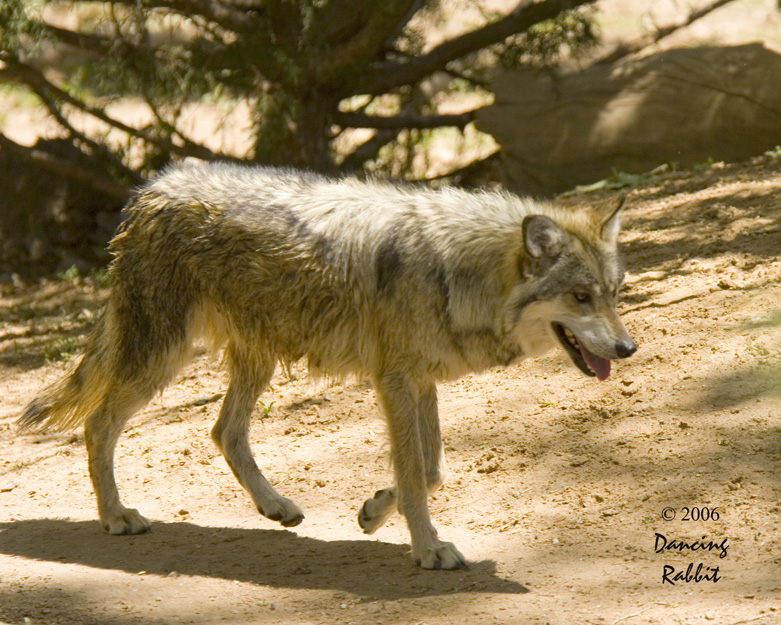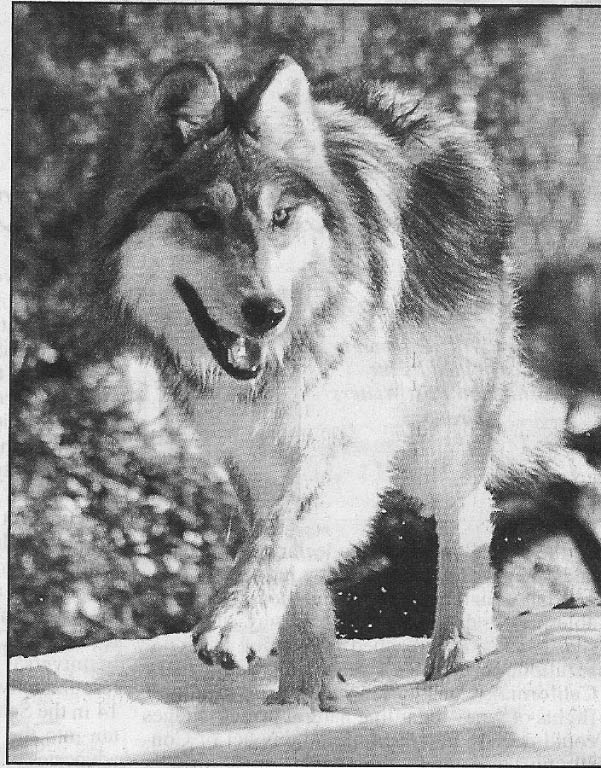Print This Article
THE TRUE TRANS-PECOS MEXICAN GRAY (LOBO) WOLF
AS SEEN IN THE BIG BEND COUNTRY OF WEST TEXAS
FROM 1870's THROUGH 1930's
[Excerpts from personal, family and neighbor recollections]
By
JOHN FRANK WOODWARD II
April 1992
[Additional material compiled by Tommy R. Woodward]
August 2006 (Updated 2007, 2008 and 2009)

Fig.1 A Mexican Gray Wolf as seen in the Albuquerque Zoo in 2006.
(Photo by Carroll Horn)
INTRODUCTION
"The Mexican gray wolf is the rarest, southernmost and most genetically distinct smaller and sub-species of the Gray Wolf, or Lobo, in North America. Until recent times, the Mexican gray wolf ranged the Sonoran and Chihuahuan deserts from central Mexico to western Texas, southern New Mexico and Central Arizona... It was hunted almost to extinction in the early 1900s. In 1976, the Mexican Gray Wolf was declared an endangered species and has remained so ever since. However, their numbers have recently grown to 102 animals in 15 packs."
STORY
Around the year 1932, I accompanied my father, J. Frank Woodward, Sr., on a rather extended wolf hunt. He was a very experienced trapper, ranch foreman, and later inheritor of part of the old Bird Ranch property located 18 miles south of Alpine. Dad was raised by his aunt and uncle, Mr. and Mrs. J.C. Bird, who had homesteaded the ranch in 1884.
It is believed that, at that time, he was in collaboration with Mr. Bruce Duncan, foreman, master trapper, and hunter for the George A. Brown-Mount Ord Ranch, who had trapped the last known lobo wolf several years earlier in the Mount Ord mountain range.
This particular animal had lost the inside toe on his left back foot and was easily identified by his tracks as the specific individual being sought. Dad had been after this predator for over three years. This had given him plenty of time to sufficiently study his habits and also enable him to predict when and where the Lobo would be coming through the area on his regular circuit.
The in-depth study of this particular animal, along with other lobos, exhibited the below mentioned characteristics. But this one lobo's circuit was also established by his kills and peculiar tracks and was found to be as follows:
The lobo entered the United States between Johnson Ranch and the town of Boquillas, on the Rio Grande. Moving northward, the lobo traveled along the Santiago Mountain Range and up Chalk Draw, where he entered the Bird Ranch. Then he turned northwest for a mile or so, and again turned due north at the mid-section line of Section 52 (where he was eventually caught) and onto the Brown Ranch (primarily a sheep ranch with good net wire fences). Following the western slopes of Mt Ord, he then entered the Jackson-Harmon (later the Richardson-Sohl) Ranch, just west of Bird Mountain. He then continued northward onto the Pate-Parr and Kimball ranches, then northeastward across the Kokernot ranch, passing the railroad station at Hovey and going about midway to Ft. Stockton.
At this point he turned eastward near where the present Highway 387 is located. From here he turned southward toward the Gage ranch, just west of Lemmon's Gap. He then continued southward passing east of the Stillwell ranch, crossing the Rio Grande, and going back into Mexico.
My great aunt Mrs. J.C. Bird and Dad quite often would tell of this earlier experience they had had with a lobo wolf:
This event took place about the year 1911, when they were alone at the ranch and heard a wolf howl after dark one night. They had a huge and very powerful dog that was part Great Dane named "Bolger" that was quite protective of them and the ranch house and when the dog heard the wolf he immediately charged out into the darkness.
Nothing more was heard or seen until the next morning when they found the scattered remains of "Bolger".... He had literally been torn into very small pieces.
Consolidating the accumulated knowledge of personal observations and many discussions with family, and other "old timers", I have found that all accounts agree on these seven basic points about the lobo wolf:
1. The lobo was an individual of very set habits.
2. Contrary to popular belief that they ran in packs, each lobo wolf was a very solitary individual and would only be seen in plural, (a) A few days after mating, and (b) When a bitch was raising her pups. As soon as she had taught them to hunt for themselves she would drive them off where each would separate for a solo life.
3. Each animal would establish a circuit of approximately 450 miles in length, returning to the same general spot about every 90 days: normally following the exact same trail. He would even go through the same hole in the fence (where he was finally trapped).
4. Each animal was continually on the move and would never spend two days in the same place.
5. He/she nearly always traveled at night and they were rarely seen in the light of day.
6. He/she would make a different kill every night from 4 to 8 miles from the last kill and always on the same circuit.
7. The preferred kill was a large calf or lone yearling, even when traveling through a sheep ranch.
One of their preferred delicacies was the marrow from the large thigh bone which was easily crushed by the extra powerful and wide jaws more resembling those of the hyena than the long and narrower-jawed East Texas Mexican wolf, or the much smaller Coyote.

Fig.2 January 1998, this Mexican Gray Wolf was just released from his cage into his new home; a 1/3 acre pen in Hannagan Meadows, AZ.
Quoting from the May 1998 issue of the National Geographic (vol. 193, no. 5, page 82):
” ... Mexican Gray Wolves, [canis lupis baileyi] the most critically endangered subspecies [of the gray wolf, canis lupus]in the lower 48, may have slipped from existence in the wild. However, a population of more than 175 has been bred in captivity from seven of the last known to exist. Federal biologists intend to start releasing some this year into national forestland spanning the Arizona-New Mexico border.”
Under the official recovery plan, their numbers have grown to about 102 animals in 25 packs(2007). For more up to date information on the U. S. Department of Interior and Forests Service monitoring status of the Gray Wolf Recovery Program, suggest you go to www.google.com and type in... Gray Wolf.
Update September 25, 2008: Under pressure from animal rights groups and a U. S. District Judge, the Fish and Wildlife Service has requested that gray wolves be put back on the endangered list. The Sierra Club, Defenders of Wildlife, the Humane Society of the United States and other groups claim that the wolf-restoration program in effect for the past 10 years has not sufficiently rescued the animal from extinction.
Judge Donald Malloy issued an injunction against public wolf hunts in Montana, Wyoming and Idaho pending the resolution of the lawsuit. If Malloy agrees with the Fish and Wildlife Service's request, the agency would then re-evaluate wolf populations in the region over the course of months, or even years, before making a decision.
Update January 15, 2009: Saying that most wolf populations have been biologically recovered for the last five years, the Bush Administration plans to remove the gray wolves in the Western Great Lakes and northern Rocky Mountains from the federal endangered species list.
Ranchers in Idaho and Montana have already drafted plans for public hunts to keep wolf populations in check. "We're the people that have to live with it." says a Montana rancher. "Maybe hunting will keep the population in check."
Return to the HISTORICAL INTERESTS page

© Tommy R. Woodward
All rights reserved.


